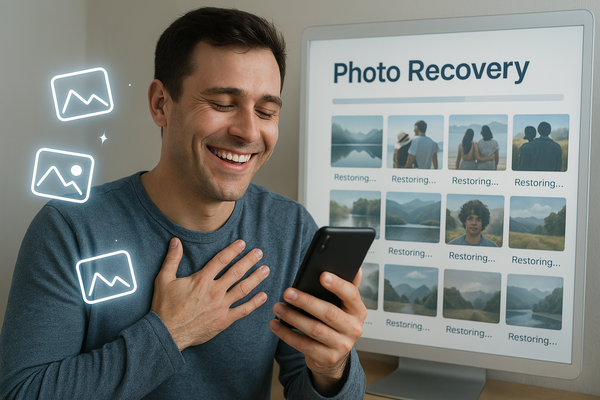Your memories have vanished? Don’t worry, not all is lost…

Dr.Fone is the tool that can turn the despair of losing iPhone photos into instant relief.
If you’ve ever experienced the frustration of accidentally deleting important images — that unforgettable trip, family moments, or snapshots from a special project — you know how distressing it can be.
The good news is that even without a backup, not everything is lost. With the right technology, it’s possible to recover deleted photos quickly and safely.
And that’s where Dr.Fone stands out: a practical, effective, and accessible solution for those who want their memories back — before it’s too late.
Why do photos disappear from the iPhone? And why is it so common?
Many people believe that deleted photos are gone forever. But what actually happens is that when you delete a file, it doesn’t immediately vanish. The system simply “marks” that space as available for new data. Until something overwrites it, the content can still be recovered.
So why do these losses happen?
- Quick gallery clean-up: deleting the wrong photo is easier than you think.
- iOS update errors: crashes during updates can cause unexpected losses.
- Unplanned factory reset: whether by mistake or necessity, erasing your iPhone without a backup can be costly.
- iCloud issues: failed syncs or accidental deactivations can remove files from the camera roll.
- Physical damage or system issues: drops, water damage, or bugs may make photos inaccessible.
And the worst part: most people only realize they lost their photos days or weeks later. That’s when the race against time begins.
Meet Dr.Fone: The smart solution to recover lost photos
Imagine an app that searches every corner of your iPhone — even the ones your system hides — and finds those images you thought were gone forever. That’s Dr.Fone: a powerful desktop software designed precisely for delicate situations like this.
What makes it special?
- It recovers photos directly from the iPhone, without needing a backup.
- Also recovers files from iCloud and iTunes backups, without full device restoration.
- Allows you to preview the files found before recovering them, giving you full control.
It’s like having a digital detective on your computer, ready to recover what you thought was lost.
How to Recover Deleted Photos from iPhone with Dr.Fone: Step-by-Step Guide
When you delete a photo on your iPhone — accidentally or not — it doesn’t always mean it’s gone for good. With the right tools, like Dr.Fone, you can undo that deletion and restore your images safely.
Here’s a complete step-by-step guide with all recovery options using Dr.Fone.
1. Recovering photos directly from the iPhone
This is the ideal method for those who don’t have a backup and need to restore recently deleted photos.
Steps:
- Install Dr.Fone on your computer (available for Windows and Mac).
- Connect your iPhone using a reliable USB cable and wait for it to be recognized.
- Access the Data Recovery module and select “Recover from iOS Device”.
- Choose the type of file you want to restore — in this case, photos.
- Click “Start” to begin scanning.
- Wait for the scan to complete — time varies depending on data size.
- Preview the files found and select only the photos you want to recover.
- Save them to your computer or, if preferred, directly to your iPhone.
2. Recovering photos from an iTunes or Finder backup
If you regularly sync your iPhone with iTunes (or Finder on Mac), this method can be your plan B.
Steps:
- Open Dr.Fone and go to “Recover from iTunes/Finder Backup”.
- The software will automatically detect backups stored on your computer.
- Select the most recent backup that contains your photos.
- Click “Start Scan” and wait for the backup to be fully analyzed.
- Once the scan is done, preview the available photos and select what you want to restore.
- Click “Recover” and save the files to the location of your choice.
3. Recovering photos from iCloud without restoring the iPhone
If you use iCloud as an automatic backup solution, this is the best way to recover lost photos without deleting what’s already on your iPhone.
Steps:
- In Dr.Fone, select “Recover from iCloud Backup”.
- Log in with your Apple ID. The app ensures total security during this process.
- Choose the desired backup (usually the most recent is best).
- Download the backup content directly into Dr.Fone.
- Wait for the data analysis — this may take a few minutes.
- After the scan, preview the files and select only the photos you want to restore.
- Click “Recover” to save them to your computer.
Why choose Dr.Fone over other apps?
There are plenty of apps that claim to recover data — but only a few actually deliver. What sets Dr.Fone apart?
- It offers three recovery methods: directly from the iPhone, local backups, and cloud backups.
- You can recover files selectively, without restoring the full backup — perfect if you want to keep recent data intact.
- Its interface is clean and user-friendly, even for non-tech users.
- Regularly updated to support the latest iOS versions and iPhone models.
- Supports various file types, including photos, videos, contacts, messages, WhatsApp history, and more.
- It offers a free version that allows you to check which files are recoverable before purchasing a license.
Is it safe? Are your files protected?
Yes. Dr.Fone runs entirely on your local machine — no files are uploaded to external servers. That means:
- Your photos and data aren’t shared with anyone.
- The app doesn’t install anything on your iPhone.
- There’s no risk of damaging your device during the process.
It’s a solution that combines performance and privacy.
5 Simple Habits to Never Lose Important Photos Again
Once you’ve recovered your images, it’s time to learn from the experience. Here are five golden tips to avoid future losses:
- Enable automatic iCloud backup — let your system save your photos daily.
- Use cloud apps like Google Photos or Dropbox — great and free alternatives.
- Transfer photos regularly to a computer or external drive.
- Be cautious when clearing space — review before deleting.
- Keep a trusted recovery app nearby — your safety net in emergencies.
Conclusion: Your photos might be closer than you think
Recovering deleted photos may seem impossible, but as we’ve seen, with the right tool — like Dr.Fone — it’s absolutely achievable. Whether due to accidental deletion, system failures, or backup issues, there’s a solution to restore what once seemed lost.
But just as important as recovering your images is preventing this from happening again. After all, no one wants to go through this stress a second time, right?
If you’re looking for even more practical ways to protect your files — or if you want a “smart trash bin” on your phone that works as a second chance for deleted content — don’t miss the next article.
In our next piece, we’ll introduce you to Dumpster — the app that acts as a digital recycle bin for Android, offering extra protection and instant file recovery.
Dumpster
Discover how to prevent future losses with the smart trash app for Android.
